jump start DODGE DURANGO 2021 Owners Manual
[x] Cancel search | Manufacturer: DODGE, Model Year: 2021, Model line: DURANGO, Model: DODGE DURANGO 2021Pages: 340, PDF Size: 20.38 MB
Page 8 of 340
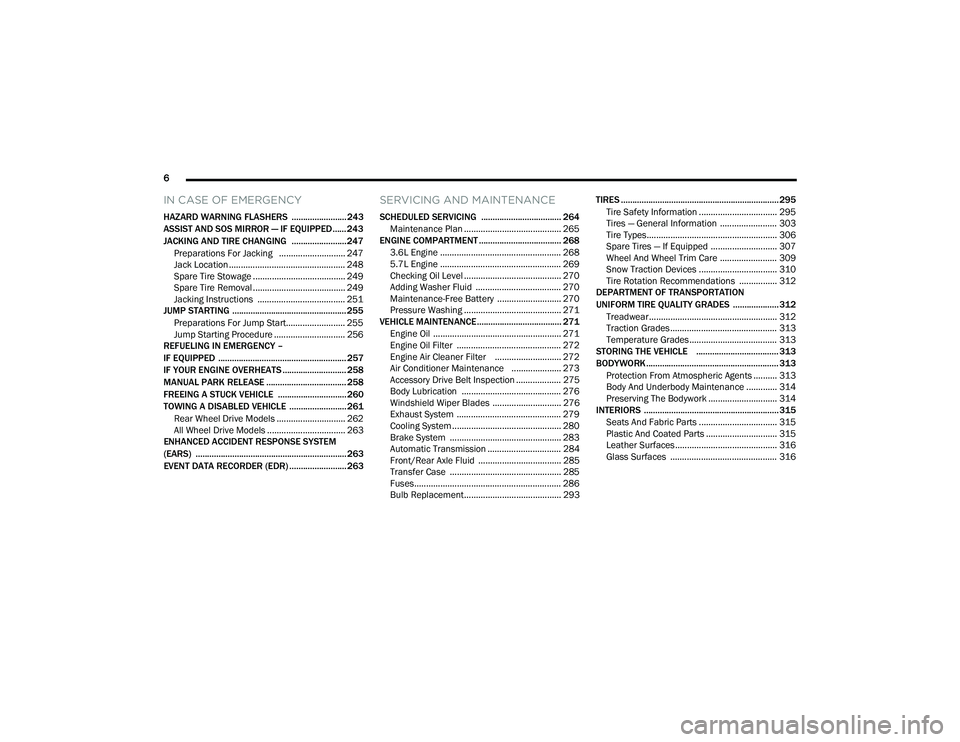
6
IN CASE OF EMERGENCY
HAZARD WARNING FLASHERS ........................ 243
ASSIST AND SOS MIRROR — IF EQUIPPED...... 243
JACKING AND TIRE CHANGING ........................ 247 Preparations For Jacking ............................ 247
Jack Location ................................................. 248
Spare Tire Stowage ....................................... 249
Spare Tire Removal ....................................... 249
Jacking Instructions ..................................... 251
JUMP STARTING .................................................. 255
Preparations For Jump Start......................... 255Jump Starting Procedure .............................. 256
REFUELING IN EMERGENCY –
IF EQUIPPED ........................................................ 257
IF YOUR ENGINE OVERHEATS ............................ 258
MANUAL PARK RELEASE ................................... 258
FREEING A STUCK VEHICLE .............................. 260
TOWING A DISABLED VEHICLE .........................261
Rear Wheel Drive Models ............................. 262
All Wheel Drive Models ................................. 263
ENHANCED ACCIDENT RESPONSE SYSTEM
(EARS) .................................................................. 263
EVENT DATA RECORDER (EDR) ......................... 263
SERVICING AND MAINTENANCE
SCHEDULED SERVICING ................................... 264
Maintenance Plan ......................................... 265
ENGINE COMPARTMENT .................................... 268
3.6L Engine ................................................... 268
5.7L Engine ................................................... 269
Checking Oil Level ......................................... 270
Adding Washer Fluid .................................... 270
Maintenance-Free Battery ........................... 270Pressure Washing ......................................... 271
VEHICLE MAINTENANCE..................................... 271
Engine Oil ...................................................... 271
Engine Oil Filter ............................................ 272
Engine Air Cleaner Filter ............................ 272
Air Conditioner Maintenance ..................... 273
Accessory Drive Belt Inspection ................... 275Body Lubrication .......................................... 276
Windshield Wiper Blades ............................. 276
Exhaust System ............................................ 279
Cooling System .............................................. 280
Brake System ............................................... 283
Automatic Transmission ............................... 284
Front/Rear Axle Fluid ................................... 285Transfer Case ............................................... 285
Fuses.............................................................. 286
Bulb Replacement......................................... 293 TIRES ..................................................................... 295
Tire Safety Information ................................. 295
Tires — General Information ........................ 303Tire Types....................................................... 306Spare Tires — If Equipped ............................ 307
Wheel And Wheel Trim Care ........................ 309Snow Traction Devices ................................. 310
Tire Rotation Recommendations ................ 312
DEPARTMENT OF TRANSPORTATION
UNIFORM TIRE QUALITY GRADES .................... 312
Treadwear...................................................... 312
Traction Grades ............................................. 313Temperature Grades..................................... 313
STORING THE VEHICLE .................................... 313
BODYWORK .......................................................... 313 Protection From Atmospheric Agents .......... 313
Body And Underbody Maintenance ............. 314
Preserving The Bodywork ............................. 314
INTERIORS ........................................................... 315
Seats And Fabric Parts ................................. 315
Plastic And Coated Parts .............................. 315
Leather Surfaces........................................... 316
Glass Surfaces ............................................. 316
21_WD_OM_EN_USC_t.book Page 6
Page 257 of 340
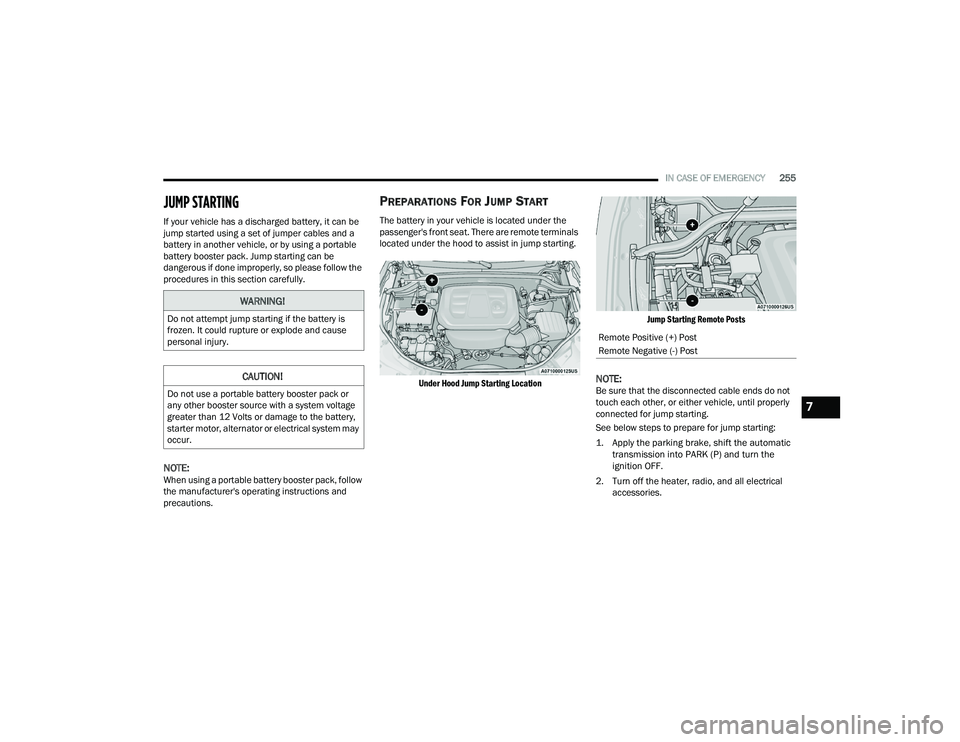
IN CASE OF EMERGENCY255
JUMP STARTING
If your vehicle has a discharged battery, it can be
jump started using a set of jumper cables and a
battery in another vehicle, or by using a portable
battery booster pack. Jump starting can be
dangerous if done improperly, so please follow the
procedures in this section carefully.
NOTE:When using a portable battery booster pack, follow
the manufacturer's operating instructions and
precautions.
PREPARATIONS FOR JUMP START
The battery in your vehicle is located under the
passenger's front seat. There are remote terminals
located under the hood to assist in jump starting.
Under Hood Jump Starting Location Jump Starting Remote Posts
NOTE:Be sure that the disconnected cable ends do not
touch each other, or either vehicle, until properly
connected for jump starting.
See below steps to prepare for jump starting:
1. Apply the parking brake, shift the automatic
transmission into PARK (P) and turn the
ignition OFF.
2. Turn off the heater, radio, and all electrical accessories.
WARNING!
Do not attempt jump starting if the battery is
frozen. It could rupture or explode and cause
personal injury.
CAUTION!
Do not use a portable battery booster pack or
any other booster source with a system voltage
greater than 12 Volts or damage to the battery,
starter motor, alternator or electrical system may
occur.
Remote Positive (+) Post
Remote Negative (-) Post
7
21_WD_OM_EN_USC_t.book Page 255
Page 258 of 340
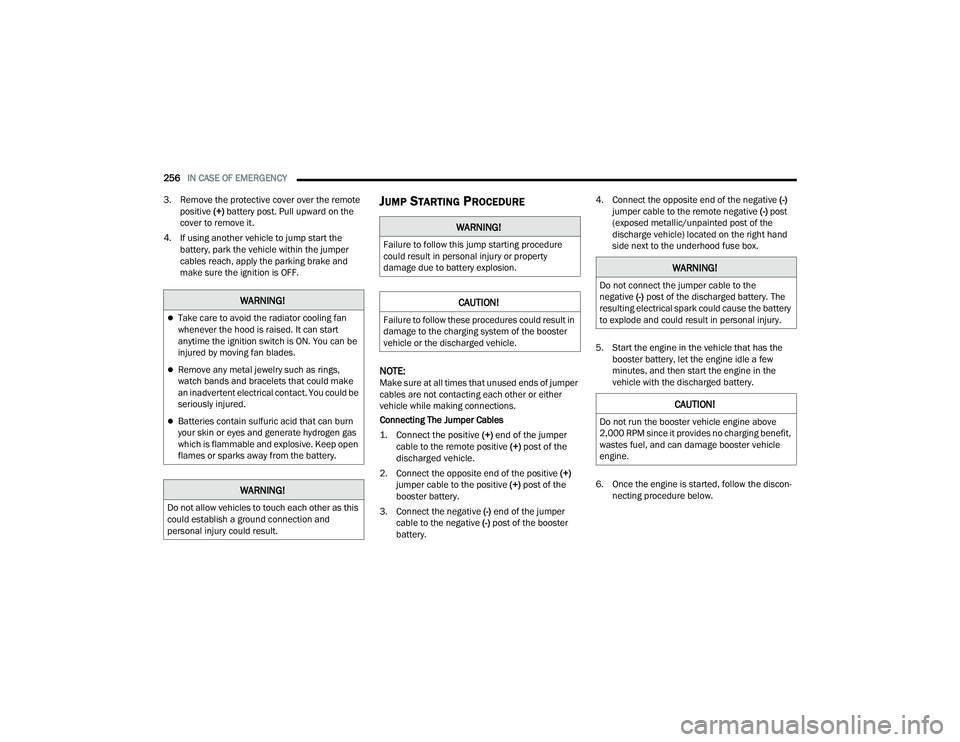
256IN CASE OF EMERGENCY
3. Remove the protective cover over the remote positive (+) battery post. Pull upward on the
cover to remove it.
4. If using another vehicle to jump start the battery, park the vehicle within the jumper
cables reach, apply the parking brake and
make sure the ignition is OFF.
JUMP STARTING PROCEDURE
NOTE:Make sure at all times that unused ends of jumper
cables are not contacting each other or either
vehicle while making connections.
Connecting The Jumper Cables
1. Connect the positive
(+) end of the jumper
cable to the remote positive (+)
post of the
discharged vehicle.
2. Connect the opposite end of the positive (+)
jumper cable to the positive (+) post of the
booster battery.
3. Connect the negative (-) end of the jumper
cable to the negative (-) post of the booster
battery. 4. Connect the opposite end of the negative
(-)
jumper cable to the remote negative (-) post
(exposed metallic/unpainted post of the
discharge vehicle) located on the right hand
side next to the underhood fuse box.
5. Start the engine in the vehicle that has the booster battery, let the engine idle a few
minutes, and then start the engine in the
vehicle with the discharged battery.
6. Once the engine is started, follow the discon -
necting procedure below.
WARNING!
Take care to avoid the radiator cooling fan
whenever the hood is raised. It can start
anytime the ignition switch is ON. You can be
injured by moving fan blades.
Remove any metal jewelry such as rings,
watch bands and bracelets that could make
an inadvertent electrical contact. You could be
seriously injured.
Batteries contain sulfuric acid that can burn
your skin or eyes and generate hydrogen gas
which is flammable and explosive. Keep open
flames or sparks away from the battery.
WARNING!
Do not allow vehicles to touch each other as this
could establish a ground connection and
personal injury could result.
WARNING!
Failure to follow this jump starting procedure
could result in personal injury or property
damage due to battery explosion.
CAUTION!
Failure to follow these procedures could result in
damage to the charging system of the booster
vehicle or the discharged vehicle.
WARNING!
Do not connect the jumper cable to the
negative (-) post of the discharged battery. The
resulting electrical spark could cause the battery
to explode and could result in personal injury.
CAUTION!
Do not run the booster vehicle engine above
2,000 RPM since it provides no charging benefit,
wastes fuel, and can damage booster vehicle
engine.
21_WD_OM_EN_USC_t.book Page 256
Page 259 of 340
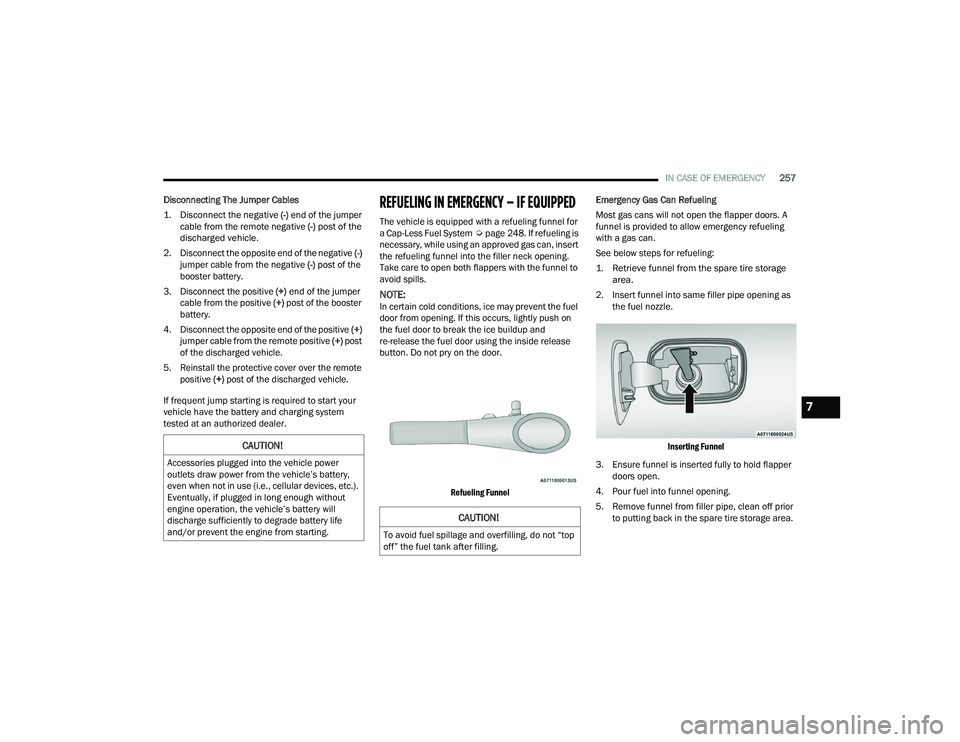
IN CASE OF EMERGENCY257
Disconnecting The Jumper Cables
1. Disconnect the negative
(-) end of the jumper
cable from the remote negative (-)
post of the
discharged vehicle.
2. Disconnect the opposite end of the negative (-)
jumper cable from the negative (-) post of the
booster battery.
3. Disconnect the positive (+) end of the jumper
cable from the positive (+) post of the booster
battery.
4. Disconnect the opposite end of the positive (+)
jumper cable from the remote positive (+) post
of the discharged vehicle.
5. Reinstall the protective cover over the remote positive (+) post of the discharged vehicle.
If frequent jump starting is required to start your
vehicle have the battery and charging system
tested at an authorized dealer.
REFUELING IN EMERGENCY – IF EQUIPPED
The vehicle is equipped with a refueling funnel for
a Cap-Less Fuel System Úpage 248. If refueling is
necessary, while using an approved gas can, insert
the refueling funnel into the filler neck opening.
Take care to open both flappers with the funnel to
avoid spills.
NOTE:In certain cold conditions, ice may prevent the fuel
door from opening. If this occurs, lightly push on
the fuel door to break the ice buildup and
re-release the fuel door using the inside release
button. Do not pry on the door.
Refueling Funnel
Emergency Gas Can Refueling
Most gas cans will not open the flapper doors. A
funnel is provided to allow emergency refueling
with a gas can.
See below steps for refueling:
1. Retrieve funnel from the spare tire storage
area.
2. Insert funnel into same filler pipe opening as the fuel nozzle.
Inserting Funnel
3. Ensure funnel is inserted fully to hold flapper doors open.
4. Pour fuel into funnel opening.
5. Remove funnel from filler pipe, clean off prior to putting back in the spare tire storage area.
CAUTION!
Accessories plugged into the vehicle power
outlets draw power from the vehicle’s battery,
even when not in use (i.e., cellular devices, etc.).
Eventually, if plugged in long enough without
engine operation, the vehicle’s battery will
discharge sufficiently to degrade battery life
and/or prevent the engine from starting.
CAUTION!
To avoid fuel spillage and overfilling, do not “top
off” the fuel tank after filling.
7
21_WD_OM_EN_USC_t.book Page 257
Page 270 of 340
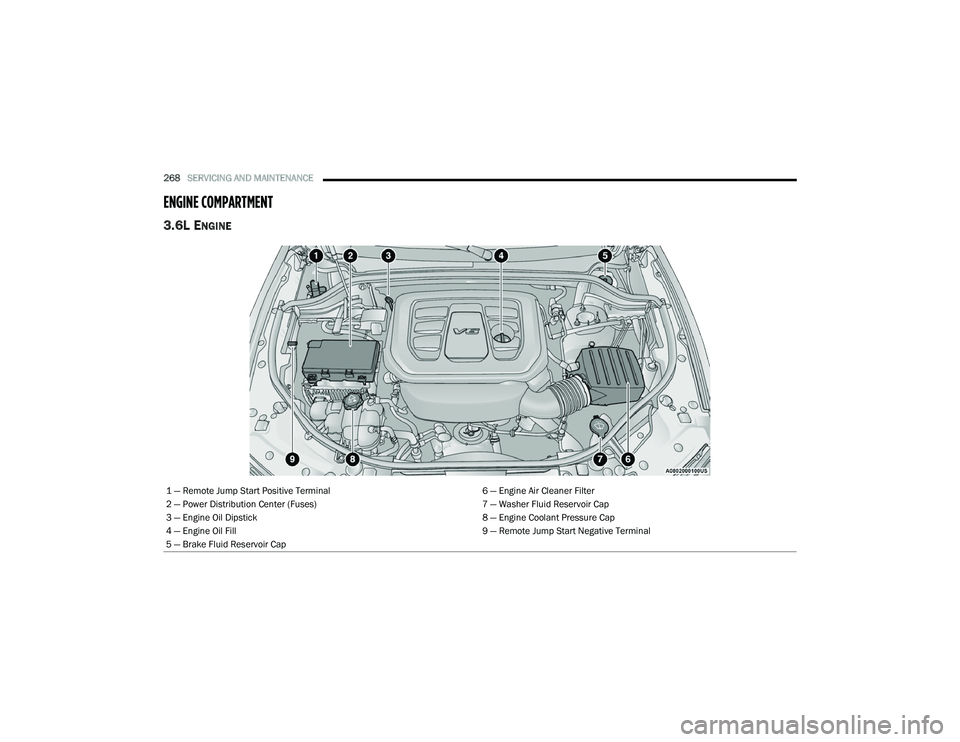
268SERVICING AND MAINTENANCE
ENGINE COMPARTMENT
3.6L ENGINE
1 — Remote Jump Start Positive Terminal 6 — Engine Air Cleaner Filter
2 — Power Distribution Center (Fuses) 7 — Washer Fluid Reservoir Cap
3 — Engine Oil Dipstick 8 — Engine Coolant Pressure Cap
4 — Engine Oil Fill 9 — Remote Jump Start Negative Terminal
5 — Brake Fluid Reservoir Cap
21_WD_OM_EN_USC_t.book Page 268
Page 271 of 340
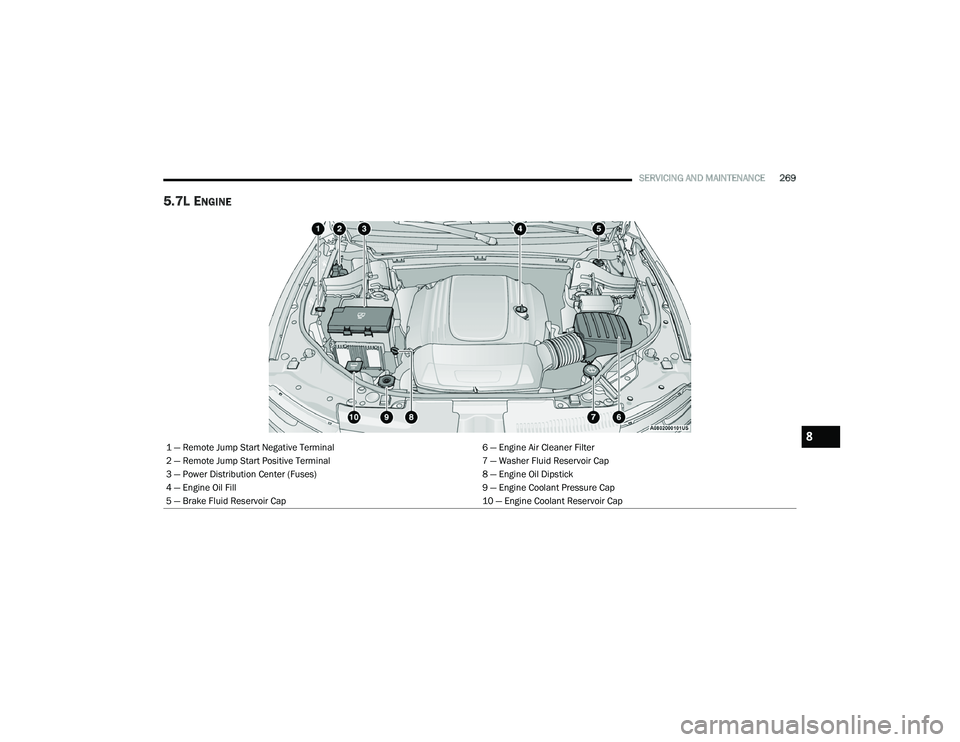
SERVICING AND MAINTENANCE269
5.7L ENGINE
1 — Remote Jump Start Negative Terminal 6 — Engine Air Cleaner Filter
2 — Remote Jump Start Positive Terminal 7 — Washer Fluid Reservoir Cap
3 — Power Distribution Center (Fuses) 8 — Engine Oil Dipstick
4 — Engine Oil Fill 9 — Engine Coolant Pressure Cap
5 — Brake Fluid Reservoir Cap 10 — Engine Coolant Reservoir Cap8
21_WD_OM_EN_USC_t.book Page 269
Page 289 of 340
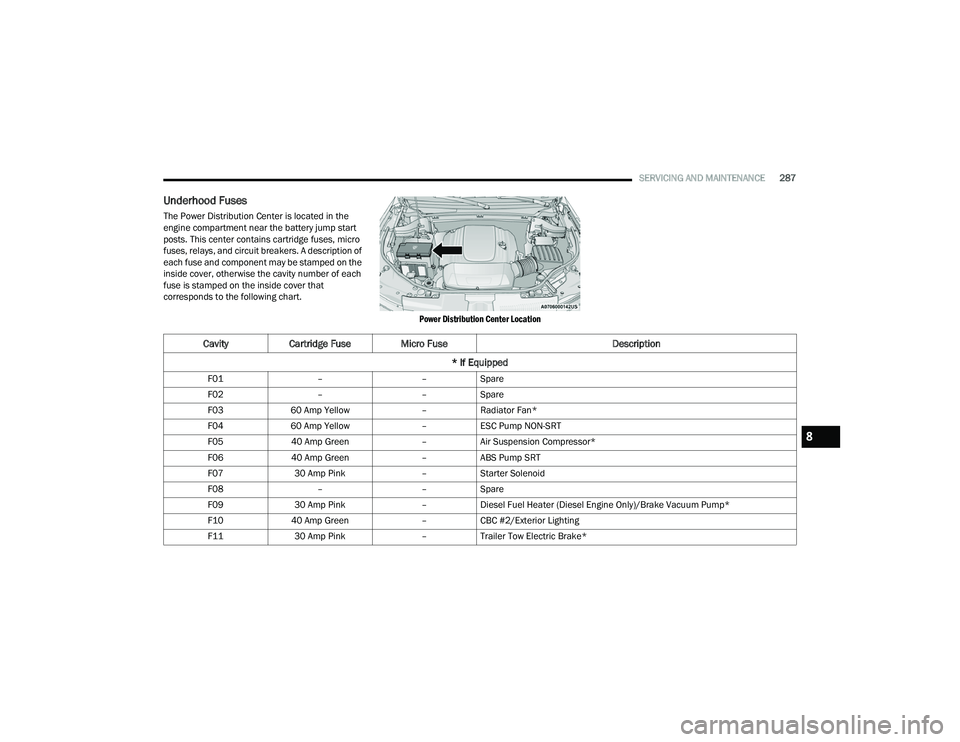
SERVICING AND MAINTENANCE287
Underhood Fuses
The Power Distribution Center is located in the
engine compartment near the battery jump start
posts. This center contains cartridge fuses, micro
fuses, relays, and circuit breakers. A description of
each fuse and component may be stamped on the
inside cover, otherwise the cavity number of each
fuse is stamped on the inside cover that
corresponds to the following chart.
Power Distribution Center Location
CavityCartridge Fuse Micro Fuse Description
* If Equipped
F01 ––Spare
F02 ––Spare
F03 60 Amp Yellow –Radiator Fan*
F04 60 Amp Yellow –ESC Pump NON-SRT
F05 40 Amp Green –Air Suspension Compressor*
F06 40 Amp Green –ABS Pump SRT
F07 30 Amp Pink –Starter Solenoid
F08 ––Spare
F09 30 Amp Pink –Diesel Fuel Heater (Diesel Engine Only)/Brake Vacuum Pump*
F10 40 Amp Green –CBC #2/Exterior Lighting
F11 30 Amp Pink –Trailer Tow Electric Brake*
8
21_WD_OM_EN_USC_t.book Page 287
Page 332 of 340
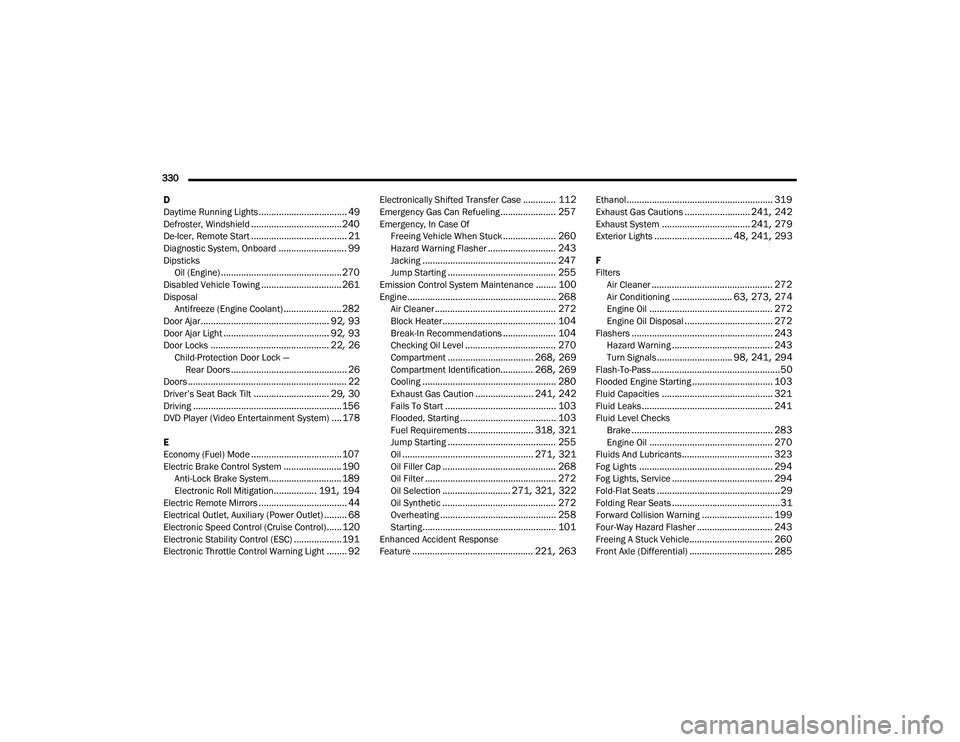
330 D
Daytime Running Lights
................................... 49Defroster, Windshield.................................... 240De-Icer, Remote Start...................................... 21Diagnostic System, Onboard........................... 99Dipsticks Oil (Engine)................................................ 270Disabled Vehicle Towing................................ 261DisposalAntifreeze (Engine Coolant)....................... 282Door Ajar................................................... 92, 93Door Ajar Light.......................................... 92, 93Door Locks............................................... 22, 26Child-Protection Door Lock —Rear Doors.............................................. 26Doors............................................................... 22Driver’s Seat Back Tilt.............................. 29, 30Driving........................................................... 156DVD Player (Video Entertainment System).... 178
E
Economy (Fuel) Mode.................................... 107Electric Brake Control System....................... 190Anti-Lock Brake System............................. 189Electronic Roll Mitigation................. 191, 194Electric Remote Mirrors................................... 44Electrical Outlet, Auxiliary (Power Outlet)......... 68Electronic Speed Control (Cruise Control)...... 120Electronic Stability Control (ESC)...................191Electronic Throttle Control Warning Light........ 92
Electronically Shifted Transfer Case............. 112Emergency Gas Can Refueling...................... 257Emergency, In Case OfFreeing Vehicle When Stuck..................... 260Hazard Warning Flasher........................... 243Jacking..................................................... 247Jump Starting........................................... 255Emission Control System Maintenance........ 100Engine........................................................... 268Air Cleaner................................................ 272Block Heater............................................. 104Break-In Recommendations..................... 104Checking Oil Level.................................... 270Compartment.................................. 268, 269Compartment Identification............. 268, 269Cooling..................................................... 280Exhaust Gas Caution....................... 241, 242Fails To Start............................................ 103Flooded, Starting...................................... 103Fuel Requirements.......................... 318, 321Jump Starting........................................... 255Oil.................................................... 271, 321Oil Filler Cap............................................. 268Oil Filter.................................................... 272Oil Selection........................... 271, 321, 322Oil Synthetic............................................. 272Overheating.............................................. 258Starting..................................................... 101Enhanced Accident Response
Feature................................................ 221, 263
Ethanol.......................................................... 319Exhaust Gas Cautions.......................... 241, 242Exhaust System................................... 241, 279Exterior Lights............................... 48, 241, 293
F
FiltersAir Cleaner
................................................ 272Air Conditioning........................ 63, 273, 274Engine Oil................................................. 272Engine Oil Disposal................................... 272Flashers........................................................ 243Hazard Warning........................................ 243Turn Signals.............................. 98, 241, 294Flash-To-Pass...................................................50Flooded Engine Starting................................ 103Fluid Capacities............................................ 321Fluid Leaks.................................................... 241Fluid Level ChecksBrake........................................................ 283Engine Oil................................................. 270Fluids And Lubricants.................................... 323Fog Lights..................................................... 294Fog Lights, Service........................................ 294Fold-Flat Seats.................................................29Folding Rear Seats...........................................31Forward Collision Warning............................ 199Four-Way Hazard Flasher.............................. 243Freeing A Stuck Vehicle................................. 260Front Axle (Differential)................................. 285
21_WD_OM_EN_USC_t.book Page 330
Page 334 of 340
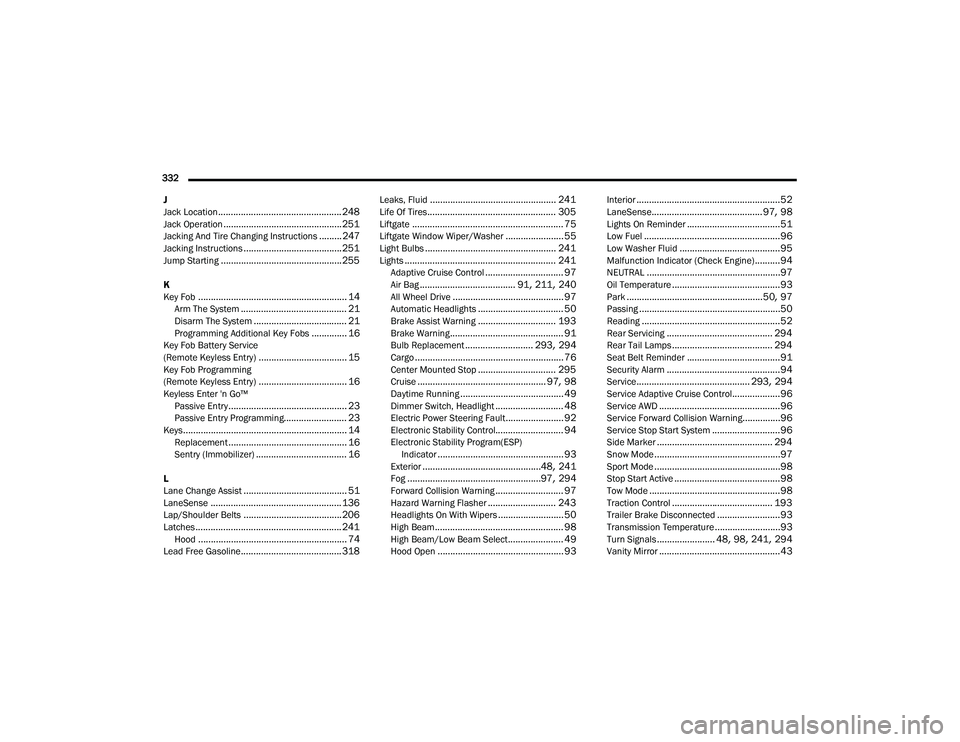
332 J
Jack Location
................................................. 248Jack Operation............................................... 251Jacking And Tire Changing Instructions......... 247Jacking Instructions....................................... 251Jump Starting................................................ 255
K
Key Fob........................................................... 14Arm The System.......................................... 21Disarm The System..................................... 21Programming Additional Key Fobs.............. 16Key Fob Battery Service
(Remote Keyless Entry)................................... 15Key Fob Programming
(Remote Keyless Entry)................................... 16Keyless Enter 'n Go™ Passive Entry............................................... 23Passive Entry Programming......................... 23Keys................................................................. 14Replacement............................................... 16Sentry (Immobilizer).................................... 16
L
Lane Change Assist......................................... 51LaneSense.................................................... 136Lap/Shoulder Belts....................................... 206Latches.......................................................... 241Hood........................................................... 74Lead Free Gasoline........................................ 318
Leaks, Fluid.................................................. 241Life Of Tires................................................... 305Liftgate............................................................ 75Liftgate Window Wiper/Washer....................... 55Light Bulbs.................................................... 241Lights............................................................ 241Adaptive Cruise Control............................... 97Air Bag...................................... 91, 211, 240All Wheel Drive............................................ 97Automatic Headlights.................................. 50Brake Assist Warning............................... 193Brake Warning............................................. 91Bulb Replacement........................... 293, 294Cargo........................................................... 76Center Mounted Stop............................... 295Cruise................................................... 97, 98Daytime Running......................................... 49Dimmer Switch, Headlight........................... 48Electric Power Steering Fault....................... 92Electronic Stability Control........................... 94Electronic Stability Program(ESP)Indicator.................................................. 93Exterior...............................................48, 241Fog.....................................................97, 294Forward Collision Warning........................... 97Hazard Warning Flasher........................... 243Headlights On With Wipers.......................... 50High Beam................................................... 98High Beam/Low Beam Select...................... 49Hood Open.................................................. 93
Interior.........................................................52LaneSense............................................ 97, 98Lights On Reminder.....................................51Low Fuel......................................................96Low Washer Fluid........................................95Malfunction Indicator (Check Engine)..........94NEUTRAL.....................................................97Oil Temperature...........................................93Park......................................................50, 97Passing........................................................50Reading.......................................................52Rear Servicing.......................................... 294Rear Tail Lamps........................................ 294Seat Belt Reminder.....................................91Security Alarm.............................................94Service............................................. 293, 294Service Adaptive Cruise Control...................96Service AWD................................................96Service Forward Collision Warning...............96Service Stop Start System...........................96Side Marker.............................................. 294Snow Mode..................................................97Sport Mode..................................................98Stop Start Active..........................................98Tow Mode....................................................98Traction Control........................................ 193Trailer Brake Disconnected.........................93Transmission Temperature..........................93Turn Signals....................... 48, 98, 241, 294Vanity Mirror................................................43
21_WD_OM_EN_USC_t.book Page 332